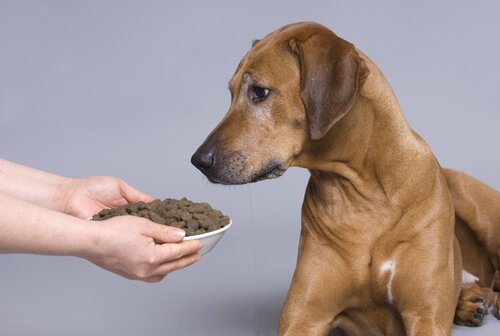How to Tell if My Dog Needs Calcium

A dog’s daily diet has to include an adequate amount of calcium to ensure its healthy development. There are some specific signs that indicate that your dog needs calcium. Would you like to know what they are? Read on!
Dogs need calcium
First of all, it’s important that you keep in mind that calcium is one of the minerals that every animal needs enough of. Most young animals, puppies, in this case, need it for the proper development and strengthening of their bones. If you want your pet to grow healthy and strong, it’s imperative that its diet contains a good amount of calcium.

The lack of this mineral can also trigger other illnesses such as rickets. This is a condition in which development is impaired and the bone structure is lower than that of other dogs of the same age and breed.
A puppy dog needs calcium, about 100 mg/lb every day. For adults, the amount decreases to 50 mg/lb. Make a note of this, as exceeding it is also bad for your dog’s health.
How to find out if your dog needs calcium
There are different ways to find out if our pet is lacking in calcium or isn’t getting the proper amount in accordance with its age and weight. Observing your pet’s body is the best way to find out if your dog needs calcium.
One way of noticing it is if it doesn’t grow enough, compared with other dogs of the same breed and age. It may also be too thin even though it eats enough. A further telltale sign is if you can see its bones through its skin.
Yet another sign is if your dog suffers from muscle spasms or seizures. Pay attention to these because in such cases their causes may not be a lack of calcium, but something more serious. Get a check-up at the vet’s!
Dogs that lack calcium may also experience other symptoms like tachycardia, disorientation, fatigue, and cardiac arrhythmias. You should get professional advice on any of these as well.
Sources of calcium for dogs
Vets may prescribe a different diet or just recommend special supplements to add to it. The vet’s diet is a good one to follow, but it’s not your only option. There are also homemade sources of calcium within your reach that may be even better.

Bones are another source of calcium. Feed them raw, or whole, chopped, or powdered with their meals or as a special extra treat.
Dairy products are another fantastic source of calcium for every mammal and adding them to your dog’s diet with greatly improve their health. For example, you can add yogurt to the dog’s dry food. It will soften it and give it a different texture and flavor. Cheese is another good addition to your dog’s diet, select the fresh kinds that have less salt and control the portions.
If your dog likes fish then feed it to them, because it’s another great source of calcium. Tuna, sardines, and trout are the best choices. Make sure it’s cooked, as raw fish could irritate the dog’s stomach and cause bacterial diseases.
Finally, if your dog likes vegetables, add spinach, broccoli, and sweet potatoes to their diets.
A dog’s daily diet has to include an adequate amount of calcium to ensure its healthy development. There are some specific signs that indicate that your dog needs calcium. Would you like to know what they are? Read on!
Dogs need calcium
First of all, it’s important that you keep in mind that calcium is one of the minerals that every animal needs enough of. Most young animals, puppies, in this case, need it for the proper development and strengthening of their bones. If you want your pet to grow healthy and strong, it’s imperative that its diet contains a good amount of calcium.

The lack of this mineral can also trigger other illnesses such as rickets. This is a condition in which development is impaired and the bone structure is lower than that of other dogs of the same age and breed.
A puppy dog needs calcium, about 100 mg/lb every day. For adults, the amount decreases to 50 mg/lb. Make a note of this, as exceeding it is also bad for your dog’s health.
How to find out if your dog needs calcium
There are different ways to find out if our pet is lacking in calcium or isn’t getting the proper amount in accordance with its age and weight. Observing your pet’s body is the best way to find out if your dog needs calcium.
One way of noticing it is if it doesn’t grow enough, compared with other dogs of the same breed and age. It may also be too thin even though it eats enough. A further telltale sign is if you can see its bones through its skin.
Yet another sign is if your dog suffers from muscle spasms or seizures. Pay attention to these because in such cases their causes may not be a lack of calcium, but something more serious. Get a check-up at the vet’s!
Dogs that lack calcium may also experience other symptoms like tachycardia, disorientation, fatigue, and cardiac arrhythmias. You should get professional advice on any of these as well.
Sources of calcium for dogs
Vets may prescribe a different diet or just recommend special supplements to add to it. The vet’s diet is a good one to follow, but it’s not your only option. There are also homemade sources of calcium within your reach that may be even better.

Bones are another source of calcium. Feed them raw, or whole, chopped, or powdered with their meals or as a special extra treat.
Dairy products are another fantastic source of calcium for every mammal and adding them to your dog’s diet with greatly improve their health. For example, you can add yogurt to the dog’s dry food. It will soften it and give it a different texture and flavor. Cheese is another good addition to your dog’s diet, select the fresh kinds that have less salt and control the portions.
If your dog likes fish then feed it to them, because it’s another great source of calcium. Tuna, sardines, and trout are the best choices. Make sure it’s cooked, as raw fish could irritate the dog’s stomach and cause bacterial diseases.
Finally, if your dog likes vegetables, add spinach, broccoli, and sweet potatoes to their diets.
This text is provided for informational purposes only and does not replace consultation with a professional. If in doubt, consult your specialist.








